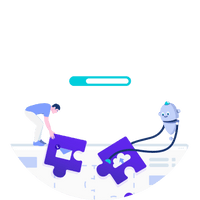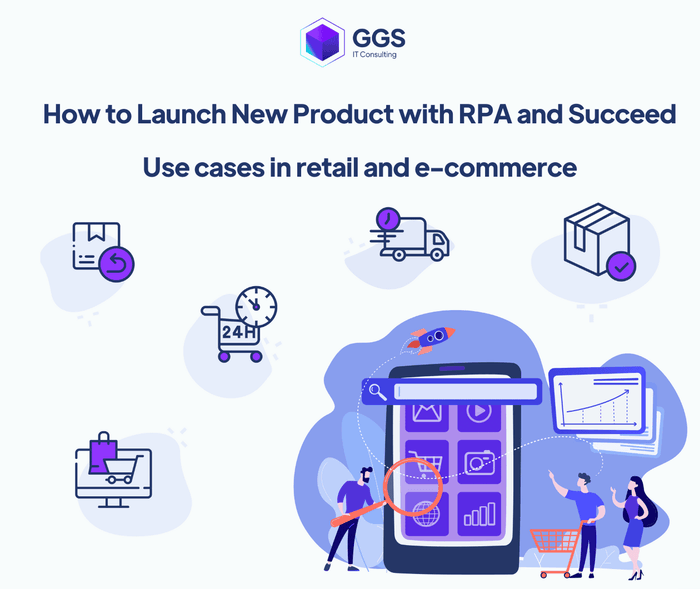
How to Launch New Product with RPA and Succeed - use cases in Retail and E-commerce

With dynamically changing market conditions, regulations, and customer expectations, enterprises need to put more effort into planning, creating, and effectively delivering new products. With a proper launch management companies are able to reduce time-to-market and maintain high levels of transparency and collaboration between internal departments and supply partners. In this article we will focus on retail and e-commerce use cases, to show how Robotic Process Automation software can be used to automate and centralize processes, supporting effective planning, monitoring, and managing product launches.
What is Robotic Process Automation (RPA)?

RPA, or Robotic Process Automation, is the name given to software that can perform tasks at the user interface (UI) level. Robots can do anything that employees do and free them from tedious, mundane, and time-consuming tasks.
RPA software is especially useful to perform repetitive tasks that have to follow a specific set of rules. Additionally, as increasing use is being made of AI, companies utilize robots to automate both front-office and back-office tasks.
Enterprises in multiple industries are benefiting from RPA by accelerating back-end processes. According to Office Worker Survey, conducted by UiPath, 67% of global office workers feel crushed by doing repetitive tasks. They would like to automate many of them, including e-mails, data input, creating datasets, scheduling calls and meetings.
Robots help fill out records and documents and can be used to:
- send automatic notifications,
- make schedule entries,
- transfer data between systems,
- create documents,
- as well as for reporting, controlling or ensuring data compliance.
The implementation of RPA requires preparation. Before replacing human workers with bots, it is essential to analyze the development model and the areas where RPA will optimize costs and working time to deliver the desired business results.
If you want to know more about RPA and its implementation, read our article “What is robotic process automation (RPA)?”.
How to use RPA for new product launches in retail and e-commerce?

With the amount of effort needed to bring new products to market each opportunity to optimize the process can be extremely beneficial for the company. In the end, the goal is to assure that everyone inside the company, sales partners, and finally target customers know about new products, and a chance to automate and streamline processes related to product launch cannot be disregarded.
Properly implemented, RPA can work faster and more effectively than humans when it comes to repetitive tasks, and help to reduce time-to-market for new products.
Because RPA is not an out-of-the-box software type it can be used effectively on all stages of product development and launch, not only for a single, specific process - and the only limitation is understanding the full potential of RPA software.
In product launch, RPA can be used to optimize manual processes, such as:
- collecting and compiling data about the competitive landscape to analyze,
- helping to gather data about customers behavior,
- streamlining communication between R&D, manufacturing, and marketing departments,
- automating marketing activities,
- modifying prices and stock levels in response to customers reactions to the product,
- supporting supply chain management.
Such a complex process as a new product launch requires improved transparency and collaboration to be successful, and properly implemented RPA software can be a factor that will limit related risks.
Competition data collection and compilation with RPA

Retailers and e-commerce companies struggle to gain a competitive advantage. The market is oversaturated with new products and without the right processes in place enterprises have problems successfully introducing a new product.
Today, the market is oversaturated with new products and innovations. Gaining a competitive edge in this highly competitive market is a challenging task. With the right processes in place, companies can successfully introduce a new product in the market and gain traction from customers.
Smaller companies deal with the problem of competition analysis manually, but when large enterprises need to gather, compile and keep track of data about dozens of competitive products, they might use dedicated competitor price monitoring software (adding another system that has to be bought and maintained) or they can benefit from RPA software flexibility.
Robotic Process Automation tools can be used to:
- visit multiple competitors’ websites to determine what they’re selling, using RPA for web scraping,
- keep track of prices and product availability,
- collect data 24/7/365, as frequently as needed, which can be useful in the planning phase, to determine how product price fluctuates, for example depending on the seasonability,
- store data in a well-structured manner, so they can be easily used by the analytics team.
RPA software is a good solution for obtaining competitor data, optimizing pricing, and improving profitability when a product is launched and changes are necessary.
How to track customers' behavior with RPA?

RPA software can collect data on customers and their buying preferences in large volume, and support advanced behavioral analytics. It is easier to capture and compile such data for e-commerce business than classic, brick and mortar stores, but it is possible in both cases.
Retailers that are preparing to introduce new products into their offer can use RPA to compile historical sales data of similar items, to see which were selling the best and when taking into account also seasonability.
With the possibility to collect data from various sources, including legacy systems and paper versions of documents (with use of OCR) we can easily imagine a situation in which Robotic Process Automation software is used by enterprises to compile shopping trends data from warehousing records, sales reports, loyalty cards and programs and online analytics.
With information on what customers are looking for, what and when they are buying, which products are most popular, and eventually which ones are going out of stock frequently, companies can plan new product launches with a better chance of success.
The biggest potential of RPA for data capture results from the lack of programming needed to access and capture data from various sources. It can be implemented without dedicated programming, which speeds up implementation between 10-20 times, compared to the time required to build dedicated software by developers.
Behavioral data can come from multiple systems, including:
- Points of Sales,
- Company website,
- CRM systems,
- Mobile apps,
- Call Centers and Help Desks.
Retailers and e-commerce companies can heavily benefit from the possibility to easily gather and compile data from those sources, which can be then quickly used in process of planning and launching new products, that will be well suited to customer needs.
How to use RPA for team communication in a product launch?
A fundamental component of a successful product launch is communication between the R&D, manufacturing, and marketing departments in the company. There are communication challenges that enterprises face and need to overcome.
A number of teams within the company have to cooperate smoothly, to assure that their contribution to product planning, design, manufacturing, marketing, and launch will be most effective.
Each department will have its own role in the process, and will need different information, for example:
- R&D needs data about customer needs to create product concepts,
- Manufacturing should be aware of production expectations,
- Sales need to have data about pricing and features,
- Marketing needs to plan promotional efforts.
RPA is not a communication software, but with flexibility and ease of implementation, it can be used to automate certain tasks related to information exchange. It can be used to set up alerts to keep up with the launch timelines, automatically distribute messages between departments or help with version control in product design.
How to automate new product marketing with RPA?
Marketing activities are full of mundane, repetitive tasks involving multiple systems that can be easily automated with the use of RPA, allowing employees to focus on more creative tasks than for example mass mailing.
Here are some examples of RPA software applications in marketing mentioned by the UiPath vendor:

Robotic process automation software can help employees by executing various manual tasks, such as:
- sending out mass emails,
- updating customers data,
- updating information about offers,
- handling complaints,
- automatically adjusting bids in PPC campaigns,
- running technical SEO reports, looking for broken links,
- gathering and compiling data for reports.
Instead of wasting manual resources on conducting those processes, marketing teams can concentrate their efforts on creating and optimizing creative campaigns that bring real results.
Modifying prices and stock levels with RPA

Day of new product launch is an important step, but not the end of challenges for companies. Before a new item is available to the public, enterprises need to work on forecasts - but when a product is selling they need to quickly respond - by modifying the price if necessary, or re-stocking on time to avoid empty shelves when the product will be more popular than predicted.
RPA software can be used to:
- Monitor stock levels and place automated orders if needed,
- Gather data about sales from various sources,
- Automatically update prices in all sale channels and systems,
- Set up automated notifications in case of supply problems.
If you would like to know more about how RPA software can be used to streamline Inventory management in retail and e-commerce, read our articles covering that topic:
Inventory Management in Retail with RPA, Use Cases and Benefits
Effective e-commerce inventory management with RPA
Supply chain management in e-commerce with RPA

It is not only essential to create, promote and sell a new product, but also to deliver it to the warehouse or directly to the customer on time and with as much visibility along the way as possible.
RPA can add security and speed to the entire logistics process, not only through already mentioned inventory management but most of all with shipping and order monitoring.
Some use cases of robotic process automation software in supply chain management include:
- eliminating, or drastically reducing manual input of purchase orders and other administrative tasks,
- eliminating human error from the processes,
- robots can work 24/7, 365 days a year, assuring that all data will be captured and passed to supply chain partners in real-time,
- RPA can capture, use and exchange data with various systems, including legacy systems, without the need for programming integration,
- with data analytics, RPA can be used to identify and optimize any inefficiencies across the supply chain.
RPA can be used in multiple ways to streamline processes across the supply chain, and in most cases, only limitations result from difficulties in proper identification and mapping processes that could be automated.
Some most common use cases can of course include automatic notifications on the order status or alerts about inventory levels. But with proper understanding business-specific, and with knowledge of the full potential of RPA, combined with AI, Machine Learning, Optical Character Recognition, and Natural Language Processing, the software can be used for more demanding tasks, such as identifying demand patterns and advanced analytics.
How we can support RPA implementation in your company?

With our experience from working on complex projects, as RPA consultants we are able to guide your company through the entire process of RPA implementation, from creating a strategy, discovering processes, designing optimal configuration, testing, up to full-scale use, and effectiveness monitoring.
GSS IT Consulting experts can support retailers in starting or scaling up digital transformation with RPA through:
- defining strategy,
- analyzing, understanding, and documenting business processes,
- setting up operating models,
- identifying technical infrastructure requirements to deploy automation solutions,
- educating employees and helping to create an “RPA-friendly” environment, where each team member looks for more automation opportunities to support company transformation,
- creating and documenting test scenarios and procedures to ensure optimal configuration,
- training our clients on building, operating, and maintaining automation solutions,
- helping to solve issues that arise in day-to-day operations with RPA software,
- further support of the implementation of any type of automation technologies by the company,
- helping to plan and set up Centers of Excellence or Process Mining Hubs, to boost up automation efforts.
If you are wondering how to improve the product launch process with RPA, get in touch with one of our consultants. You can book a free 30 minutes consultation with us and we will help you identify your needs and pick the right technology to match your challenges.
After completing the form, we will arrange a call at a time convenient for you. During the call, our consultant will suggest how to approach the Robotic Process Automation initiative in your Company.
